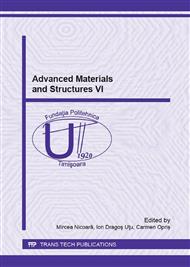[1]
T. Sadowski, P. Golewski, The influence of quantity and distribution of cooling channels of turbine elements on level of stresses in the protective layer TBC and the efficiency of cooling, Comput. Materials Sci. 52 (2012) 293–297.
DOI: 10.1016/j.commatsci.2011.02.027
Google Scholar
[2]
T. Sadowski, K. Nakonieczny, Thermal shock response of FGM cylindrical plates with various grading patterns, Compt. Materials Sci. 43 (2008) 171–178.
DOI: 10.1016/j.commatsci.2007.07.051
Google Scholar
[3]
T. Sadowski and P. Golewski, Multidisciplinary analysis of the operational temperature increase of turbine blades in combustion engines by application of the ceramic thermal barrier coatings (TBC), Comput. Materials Sci. 50 (2011) 1326–1335.
DOI: 10.1016/j.commatsci.2010.05.032
Google Scholar
[4]
E. Postek, T. Sadowski, Assessing the Influence of Porosity in the Deformation of Metal-Ceramic Composites, Composite Interfaces 18 (2011) 57-76.
DOI: 10.1163/092764410x554049
Google Scholar
[5]
T. Sadowski, B. Pankowski, Numerical modelling of two-phase ceramic composite response under uniaxial loading, Composite Structures 143 (2016) 388-394.
DOI: 10.1016/j.compstruct.2016.02.022
Google Scholar
[6]
L.A. Gömze, L.N. Gömze, Alumina-based hetero-modulus ceramic composites with extreme dynamic strength – phase transformation of Si3N4 during high speed collision with metallic bodies, Ĕpitöanyag – Journal of Silicate Based and Composite Materials 61 (2009).
DOI: 10.14382/epitoanyag-jsbcm.2009.7
Google Scholar
[7]
T. Sadowski, P. Golewski, Detection and numerical analysis of the most efforted places in turbine blades under real working conditions, Comp. Mater. Sci. 64 (2012) 285-288.
DOI: 10.1016/j.commatsci.2012.02.048
Google Scholar
[8]
G. Golewski, P. Golewski, T. Sadowski, Numerical modeling crack propagation under Mode II fracture in plain concretes containing siliceous fly-ash additive using XFEM method, Comput. Mat. Sci. 62 (2012) 75-78.
DOI: 10.1016/j.commatsci.2012.05.009
Google Scholar
[9]
T. Sadowski, M. Birsan, D. Pietras, Numerical analysis of multilayered and FGM structural elements under mechanical and thermal loads. Comparison of the finite elements and analytical models, Arch. of Civil and Mechanical Eng. 15 (2015) 1180-1192.
DOI: 10.1016/j.acme.2014.09.004
Google Scholar
[10]
J. Bieniaś, H. Dębski H., B. Surowska B., T. Sadowski, Analysis of microstructure damage in carbon/epoxy composites using FEM, Comput. Mat. Sci. 64 (2012) 168-172.
DOI: 10.1016/j.commatsci.2012.03.033
Google Scholar
[11]
V. Petrova, T. Sadowski, Theoretical modeling and analysis of thermal fracture of semi-infinite functionally graded materials with edge cracks, Meccanica 49 (2014) 2603–2615.
DOI: 10.1007/s11012-014-9941-x
Google Scholar
[12]
V.N. Burlayenko, H. Altenbach, T. Sadowski, S.D. Dimitrova, Computational simulations of thermal shock cracking by the virtual crack closure technique in a functionally graded plate, Computational Materials Science 116 (2016) 11-21.
DOI: 10.1016/j.commatsci.2015.08.038
Google Scholar
[13]
H. Dębski, T. Sadowski, Modelling of microcracks initation and evolution along interfaces of the WC/Co composite by the finite element method, Computational Materials Science 83 (2014), 403-411.
DOI: 10.1016/j.commatsci.2013.11.045
Google Scholar
[14]
T. Sadowski, Gradual degradation in two-phase ceramic composites under compression, Comput. Materials Sci. 64 (2012) 209–211.
DOI: 10.1016/j.commatsci.2012.01.034
Google Scholar
[15]
V. Birman and L. W. Byrd, Rewiew of Fracture and Fatigue in Ceramic Matrix Composites, Appl. Mech. Rev. 53 (2000) 147–174.
DOI: 10.1115/1.3097345
Google Scholar
[16]
A. Krell and S. Schädlich, Nanoindentation hardness of submicrometer alumina ceramics, Materials Sci. Eng. A, 307 (2001) 172–181.
DOI: 10.1016/s0921-5093(00)01818-9
Google Scholar
[17]
T. Sadowski and L. Marsavina, Multiscale modelling of two-phase Ceramic Matrix Composites: Comput. Materials Sci. 50 (2011) 1336–1346.
DOI: 10.1016/j.commatsci.2010.04.011
Google Scholar
[18]
M. S. Breitenfeld, P. H. Geubelle, O. Weckner, and S. A. Silling, Non-ordinary state-based peridynamic analysis of stationary crack problems, Computer Methods in Applied Mechanics and Engineering 272 (2014) 233–250.
DOI: 10.1016/j.cma.2014.01.002
Google Scholar
[19]
S. A. Silling, Reformulation of elasticity theory for discontinuities and long-range forces, J. Mech. Phys. Solids 48 (2000) 175–209.
DOI: 10.1016/s0022-5096(99)00029-0
Google Scholar
[20]
S. A. Silling, O. Weckner, E. Askari, and F. Bobaru, Crack nucleation in a peridynamic solid, Int. J. Fracture 162 (2010) 219–227.
DOI: 10.1007/s10704-010-9447-z
Google Scholar
[21]
R. Quey, P. R. Dawson, and F. Barbe, Large-scale 3D random polycrystals for the finite element method: Generation, meshing and remeshing, Computer Methods in Applied Mechanics and Engineering 200 (2011) 1729–1745.
DOI: 10.1016/j.cma.2011.01.002
Google Scholar
[22]
J. F. Shackelford and W. Alexander, CRC materials science and engineering handbook, 3rd ed. Boca Raton, FL: CRC Press, (2001).
Google Scholar
[23]
K. Niihara, A fracture mechanics analysis of indentation-induced Palmqvist crack in ceramics, J. Mater. Sci. Lett. 2 (1983) 221–223.
DOI: 10.1007/bf00725625
Google Scholar
[24]
S. L. Jones, C. J. Norman, and R. Shahani, Crack-profile shapes formed under a Vickers indent pyramid, J. Mater. Sci. Lett. 6 (1987) 721–723.
DOI: 10.1007/bf01770938
Google Scholar


